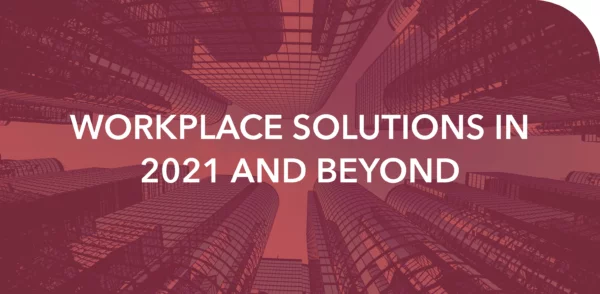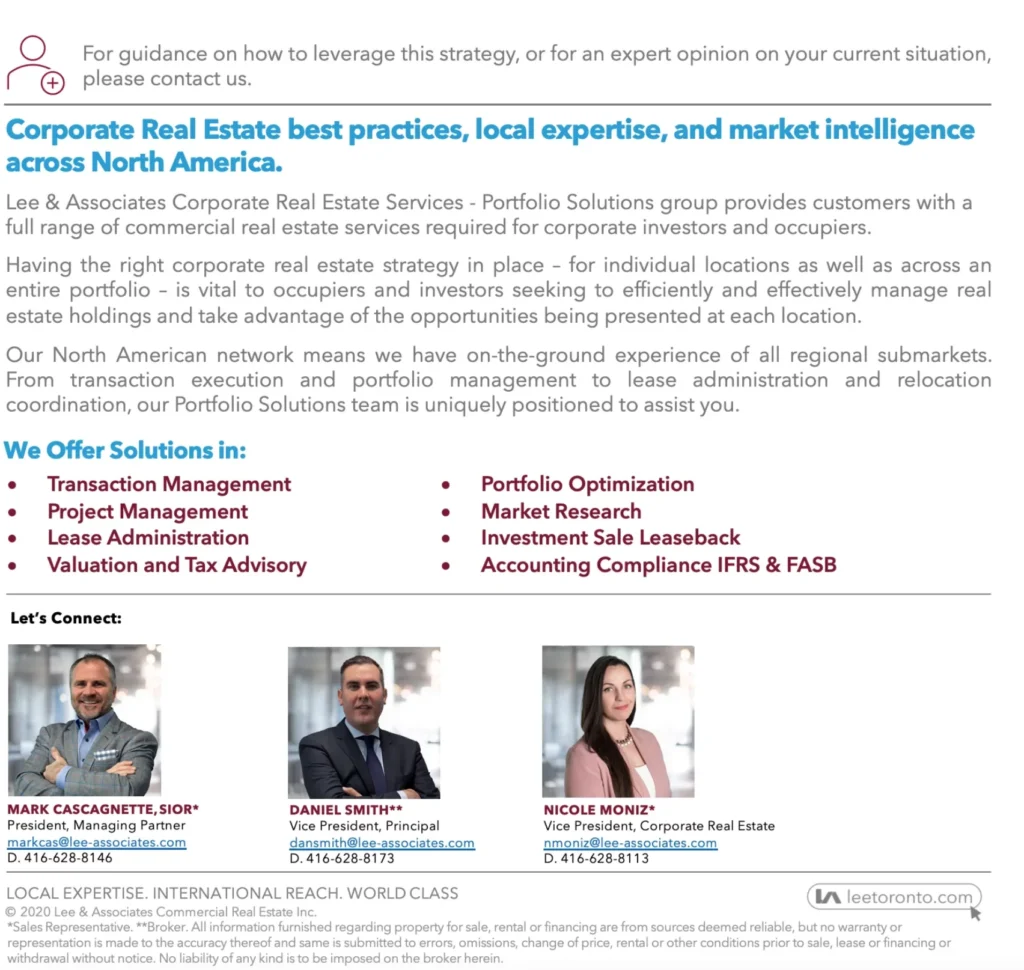WORKPLACE SOLUTIONS IN 2021 AND BEYOND
January 28, 2021

While the early part of 2020 placed many corporations in a reactionary role to, first and foremost, secure the safety of their employees and then the continuation of business operations, the latter half saw decision makers largely in a ‘wait and see’ mode. Markets were pushed out of balance and expectations of Landlords and Tenants diverged as parties sought to forecast how events would play out. This saw trade volumes drop significantly; however, it also brought many Tenants to the negotiating table as they dealt with Landlords regarding rent deferrals, abatements, concessions, and in some cases, termination of contracts.
Now, as we head into a new year with many months of data and experiences to lean on, many businesses are re-evaluating their real estate footprints to reflect safety standards and protocols, as well as the broader needs of the workforce and of the corporation.
A big question mark still remains surrounding the long-term size, form, and function of space.
To that end, flexibility will be a key feature in all facets of real estate; from offices and manufacturing facilities to rents and contract negotiations. So, with that in mind, let’s examine some trends and solutions that corporations should look to leverage in the coming year.
Evolution of the Workplace
Corporations largely embraced the idea of the ‘cubicle’ for decades, as it was held to be the ideal way to maintain flexibility, flow, and privacy – which all were believed to increase productivity.
In the late 1990’s and early 2000’s, the pendulum swung the other way as designers addressed the downsides of these arrangements. These were primarily the breaking down of hierarchical and departmental walls to allow for collaboration and ‘spontaneous interaction’ between employees who would normally rarely encounter one another.
The ‘office-as-life-style’ movement came to a head with the open-office concept and lavish amenities such as nap rooms, espresso bars, game rooms, and fitness centres; anything to encourage longer hours at the office.
However, “the digital resources that now allow many workers to do their jobs from home had made it possible to come into the office and spend all day online. Although these tools claim to enhance the physical workspace by improving communication, they can undermine office culture by reducing the face-to-face encounters that open-plan layouts purport to promote.”
Now, with remote work being adopted out of necessity, and many Tenants weighing their options, there may be a golden opportunity to re-imagine the workplace of the future.
Workplace Trends for 2021 and Beyond
Here are some of the trends we are watching, as told by The New Yorker:
Remote Work
“Remote work was working, by and large. Thirty per cent of supervisors said that their workers were more productive at home; only seven per cent said people were getting less done.”
“Two months into the pandemic, it seemed likely that working from home would be a permanent change, rather than a temporary stopgap.”
Part-Time In-Office Schedules
“Everyone said that they missed seeing their colleagues in person, but very few workers envisaged returning to the office five days a week. One to three days was more appealing.”
Decentralized Space and Real Estate
“Instead of a big central office with seating for twelve hundred and fifty employees and a two-hundred-person conference room, it might be better to have smaller satellite offices nearer to workers’ homes.”
Not only can employees shorten their commutes and realize an improved work-life balance, but this approach may hedge against future outbreaks by separating teams and leverage lower rents in suburban markets.
Safety Protocols
Finally, we should continue to see workplaces expand to accommodate for socially distanced desks and work stations. In addition, upgraded HVAC systems to reduce airborne transmission of any potential viruses, and improved cleaning and hygiene protocols will aid in keeping workers safe, comfortable, and productive.
Corporate Solutions to Navigate Uncertainty
Planning and implementing corporate solutions should address the concerns of cost control and labour productivity.
Specifically, it should seek to answer the questions:
“What’s an office for? Is it a place for newbies to learn from experienced colleagues? A way for bosses to oversee shirkers? A platform for collaboration? A source of friends and social life? A respite from the family? A reason to leave the house? It turns out that work, which is what the office was supposed to be for, is possible to do from somewhere else.”
Speaking generally, solutions should provide:
- More spaces for collaborating;
- Less individual desk space;
- More team-oriented spaces that allow for informal meetings instead of everything requiring a conference room;
- Less overwhelming layouts that make it hard to concentrates.
As well as try to remedy the ‘pain points’ as described by corporate management professionals, including:
- A lack of spontaneous interactions with colleagues;
- Difficulty integrating new hires into company culture remotely;
- Zoom fatigue
- Ergonomically incorrect seating; and
- Working from home with young children.
Not only can strategic market planning and other real estate solutions provide direct benefits to the workplace, but they can have a large impact on the business, its risks, and its bottom line.
The Pros and Cons Associated with Strategic Market Planning
To the Corporation:
- Possible short-term rent relief;
- Mitigate sharp rent increases upon expiry;
- Long-term rent predictability;
- Possible TIs or concessions from Landlord;
- Possible increase in investing in short-term;
- Increased costs in altering layouts, cleaning offices, and space per employee; and
- Mitigate risks associated with potential long-term work-from-home scenarios.
To the Employee:
- Increased employee retention;
- Increased worker productivity, engagement, and safety;
- Long-term preservation of workplace culture; and
- Increased safety from staggered, partial occupancies while providing social and collaborative benefits of an office.
Summary
Overall, Tenants and Landlords of commercial space are constantly looking for opportunities to minimize costs and risks associated with their workplaces and broader real estate footprints.
Strategic market planning, rightsizing, renewing, renegotiating, and relocating are tools that may provide immediate rent relief or longer-term assurances in costs that enable more accurate forecasting. They can also give corporations and their employees the confidence they need to return to work safely. Given the uncertainty in the world at-large, it may be prudent to explore all pertinent options available in order to make the best decision possible.

